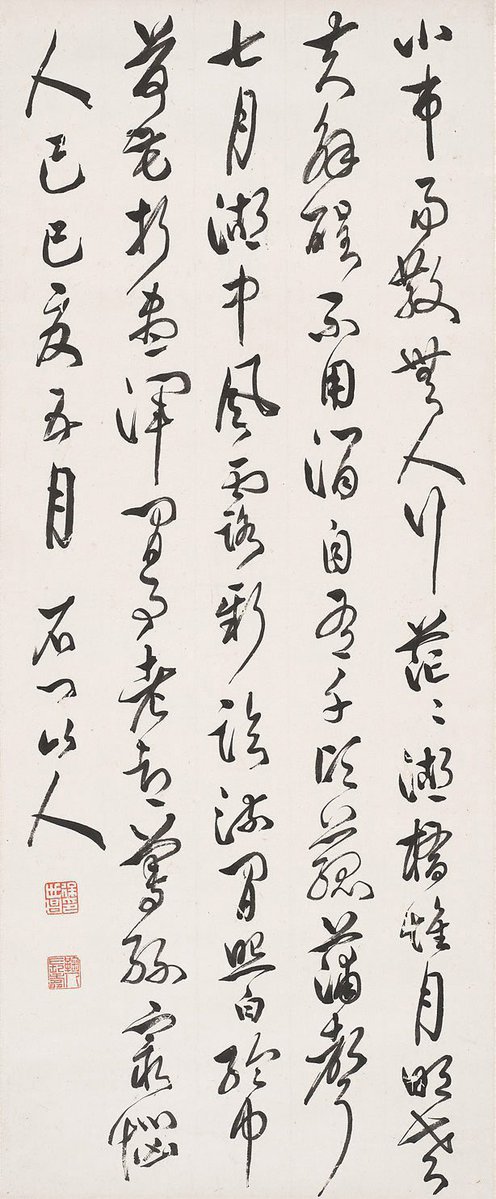-
Details
- Place where the work was made
-
China
- Media categories
- Scroll , Calligraphy
- Materials used
- hanging scroll; ink on paper
- Dimensions
- 90.0 x 37.1 cm image; 158.0 x 59.0 cm scroll
- Signature & date
Signed c.l. part b, in Chinese, inscribed in black ink "...Written in the summer, the fifth moon of the year of Jisi (1929) by Shimen shanren".
Signed l.l., in Chinese, stamped in red ink “Xu Shichang Yin [artist's seal]".
Signed l.l., in Chinese, stamped in red ink “Juren changshou [artist's seal]".- Credit
- Gift of Dr. James Hayes 2003
- Location
- Not on display
- Accession number
- 298.2003
- Copyright
- Artist information
-
Xu Shichang
Works in the collection
- Share
-
-
About
‘With no trace of men, the market readily disperses,
Now only the moon sheds a hazy light on the lake bridge.
To recover from a hangover the old man doesn’t need wine,
There are sounds of a thousand wild reeds.In July the wind and dew from the lake are new,
At leisure I look into the mirror-like water to see my white headwear.
Although the disappearance of lotus is not my concern,
It still stirs melancholy when the waterweeds wither up.’
Inscription and signature: Written in the summer, fifth moon of the year jisi [1929] by Shimenn shanren.Xu Shichang (alias Puwu, style name Juren) was a prominent politician during the Republican period. A native of Tianjing, he was born in Henan, received his ‘jinshi’ degree in 1886, and became a compiler at the Hanlin Academy. He held a series of senior positions in the Qing court, including deputy minister of the Ministry of War, minister of the State Council, minister of police, and viceroy of Manchuria. When China became a republic, Xu was appointed as state secretary, and in 1918 he became president of the Republic of China. In 1922 he retired to Tianjing, and spent the rest of his life painting and doing calligraphy.
This calligraphy was done during his later years in retirement, and is composed of two poems by the famous Southern Song dynasty poet Lu You (1125–1210) (1). Lu had an unsuccessful official career and soon retired in frustration, returning to his home town of Shaoxing. He went on to be regarded as one of the greatest poets in Chinese literary history. The two poems, written during his absence from the court, express his loneliness and an acute awareness of the passing of time. It was such melancholy sentiments that struck a responsive chord in Xu’s consciousness.
Xu Shichang was an advocate of the conventional style of ‘tiexue’, based on the study of classical calligraphy models. He uses his running script to great advantage, displaying a carefree grace while maintaining the complexity of the style.
1 Lu You, ‘Two poems written during boating on the lake in late summer and early autumn in the year yichou (Yichou xiaqiu zhi jiao xiaozhou zaowan wanglai huzhong jueju)’.
‘The Poetic Mandarin: Chinese Calligraphy from the James Hayes Collection’. pg.92.
© 2005 Art Gallery of New South Wales -
Places
Where the work was made
China
-
Exhibition history
Shown in 1 exhibition
The poetic mandarin: Chinese calligraphy from the James Hayes collection, Art Gallery of New South Wales, Sydney, 23 Sep 2005–27 Nov 2005
-
Bibliography
Referenced in 1 publication
-
LIU Yang, The poetic mandarin: Chinese calligraphy from the James Hayes collection, Sydney, 2005, 92, 93 (illus.). cat.no. 24
-
